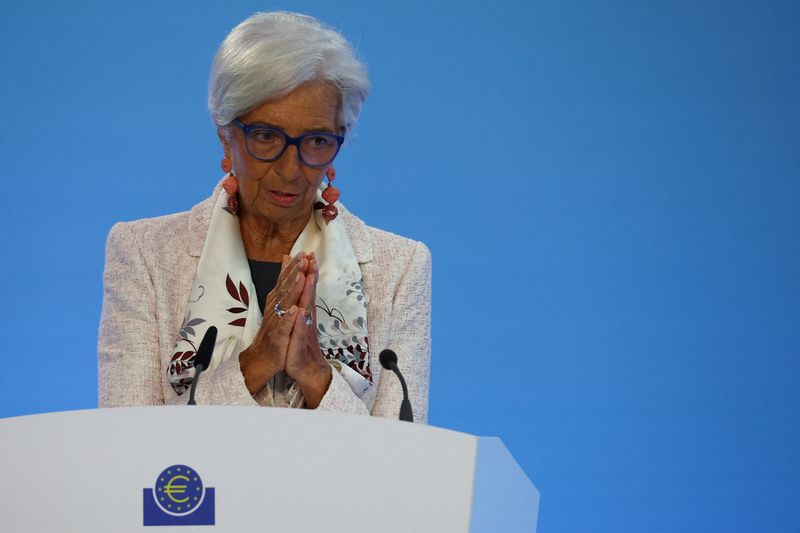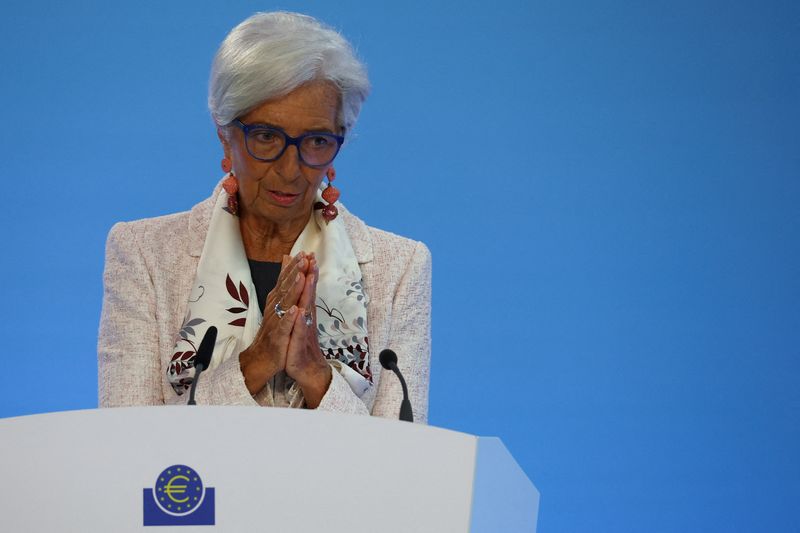Economy
Global central banks begin policy shift as inflation cools


© Reuters. FILE PHOTO: European Central Bank (ECB) President Christine Lagarde speaks to the media following the Governing Council’s monetary policy meeting at ECB headquarters in Frankfurt, Germany, July 27, 2023. REUTERS/Kai Pfaffenbach/File Photo
2/2
By Howard Schneider and Francesco Canepa
WASHINGTON/FRANKFURT (Reuters) – Top central banks continued with another round of interest rate hikes this week despite cooling inflation, but have now switched in unison to a more cautious posture about further moves in a sign that a year-long round of global monetary tightening could be at an end.
The U.S. Federal Reserve and the European Central Bank delivered quarter-percentage-point rate increases this week, as expected, and left open the option of further hikes if inflation didn’t continue a decline that has started to come faster than expected on both sides of the Atlantic.
The Bank of England is expected to raise rates again next week following similar positive inflation news, while the Bank of Japan, which meets on Friday, is expected to at least open debate on plans to bring its ultra-loose policies to an end.
Yet the hike-first rhetoric, common among top policymakers since last year, has now been coupled with a broader view of how prices are evolving alongside the economy as a whole, a more comprehensive approach that could allow slower job and economic growth to serve as its own evidence that inflation will continue to fall.
That’s a switch from policymakers’ insistence over the past year that they needed to see actual declines in the pace of price rises to know progress was being made, and one that could inject what Fed Chair Jerome Powell described as a dose of patience into the debate over whether more rate hikes are needed.
The Fed’s benchmark overnight interest rate now stands in the 5.25%-5.50% range, while the ECB’s main rate is 3.75%.
“Given how far we’ve come, we can afford to be a little patient as well as resolute as we let this unfold,” Powell said in a press conference on Wednesday following the Fed’s decision to raise rates for the 11th time in its last 12 meetings. “We want to see economic growth running at moderate or modest levels to help ease inflationary pressures. We want to see continued restoration of supply and demand balance, particularly in the labor market … We see those pieces of the puzzle coming together.”
‘OPEN MIND’
For the ECB, President Christine Lagarde said a slight wording change in its latest policy statement was “not just random or irrelevant,” but meant to communicate that after nine straight rate increases a pause would be on the table at the central bank’s meeting in September, just as it will be for the U.S. central bank.
“We have an open mind as to what the decision will be in September and subsequent meetings,” Lagarde said. “We might hike. We might hold … I hope it is very clear that we are not in the domain of forward guidance.”
New U.S. gross domestic product data on Thursday showed the path to a global pause is far from clear in an economy that continues to confound.
The economy grew at a faster-than-anticipated 2.4% annual rate in the second quarter, well above the 1.8% annual rate that Fed officials regard as the approximate trend consistent with their 2% inflation target. Yet quarterly inflation data came in weaker than expected.
While bond markets took a cue from the faster growth, and pushed yields on Treasuries higher, the days of coordinated global tightening may be numbered.
Though there was “material risk” inflation may still require further hikes, wrote Evercore ISI Vice Chairman Krishna Guha, “in the base case, the ECB – like the Fed – is done raising rates.”
Economy
Russian central bank says it needs months to make sure CPI falling before rate cuts -RBC


© Reuters. Russian Central Bank Governor Elvira Nabiullina attends a news conference in Moscow, Russia June 14, 2019. REUTERS/Shamil Zhumatov/File Photo
MOSCOW (Reuters) – Russia’s central bank will need two to three months to make sure that inflation is steadily declining before taking any decision on interest rate cuts, the bank’s governor Elvira Nabiullina told RBC media on Sunday.
The central bank raised its key interest rate by 100 basis points to 16% earlier in December, hiking for the fifth consecutive meeting in response to stubborn inflation, and suggested that its tightening cycle was nearly over.
Nabiullina said it was not yet clear when exactly the regulator would start cutting rates, however.
“We really need to make sure that inflation is steadily decreasing, that these are not one-off factors that can affect the rate of price growth in a particular month,” she said.
Nabiullina said the bank was taking into account a wide range of indicators but primarily those that “characterize the stability of inflation”.
“This will take two or three months or more – it depends on how much the wide range of indicators that characterize sustainable inflation declines,” she said.
The bank will next convene to set its benchmark rate on Feb. 16.
The governor also said the bank should have started monetary policy tightening earlier than in July, when it embarked on the rate-hiking cycle.
Economy
China identifies second set of projects in $140 billion spending plan


© Reuters. FILE PHOTO: Workers walk past an under-construction area with completed office towers in the background, in Shenzhen’s Qianhai new district, Guangdong province, China August 25, 2023. REUTERS/David Kirton/File Photo
SHANGHAI (Reuters) – China’s top planning body said on Saturday it had identified a second batch of public investment projects, including flood control and disaster relief programmes, under a bond issuance and investment plan announced in October to boost the economy.
With the latest tranche, China has now earmarked more than 800 billion yuan of its 1 trillion yuan ($140 billion) in additional government bond issuance in the fourth quarter, as it focuses on fiscal steps to shore up the flagging economy.
The National Development and Reform Commission (NDRC) said in a statement on Saturday it had identified 9,600 projects with planned investment of more than 560 billion yuan.
China’s economy, the world’s second largest, is struggling to regain its footing post-COVID-19 as policymakers grapple with tepid consumer demand, weak exports, falling foreign investment and a deepening real estate crisis.
The 1 trillion yuan in additional bond issuance will widen China’s 2023 budget deficit ratio to around 3.8 percent from 3 percent, the state-run Xinhua news agency has said.
“Construction of the projects will improve China’s flood control system, emergency response mechanism and disaster relief capabilities, and better protect people’s lives and property, so it is very significant,” the NDRC said.
The agency said it will coordinate with other government bodies to make sure that funds are allocated speedily for investment and that high standards of quality are maintained in project construction.
($1 = 7.1315 renminbi)
Economy
Russian central bank says it needs months to make sure CPI falling before rate cuts -RBC


© Reuters. Russian Central Bank Governor Elvira Nabiullina attends a news conference in Moscow, Russia June 14, 2019. REUTERS/Shamil Zhumatov/File Photo
MOSCOW (Reuters) – Russia’s central bank will need two to three months to make sure that inflation is steadily declining before taking any decision on interest rate cuts, the bank’s governor Elvira Nabiullina told RBC media on Sunday.
The central bank raised its key interest rate by 100 basis points to 16% earlier in December, hiking for the fifth consecutive meeting in response to stubborn inflation, and suggested that its tightening cycle was nearly over.
Nabiullina said it was not yet clear when exactly the regulator would start cutting rates, however.
“We really need to make sure that inflation is steadily decreasing, that these are not one-off factors that can affect the rate of price growth in a particular month,” she said.
Nabiullina said the bank was taking into account a wide range of indicators but primarily those that “characterize the stability of inflation”.
“This will take two or three months or more – it depends on how much the wide range of indicators that characterize sustainable inflation declines,” she said.
The bank will next convene to set its benchmark rate on Feb. 16.
The governor also said the bank should have started monetary policy tightening earlier than in July, when it embarked on the rate-hiking cycle.

 Forex2 years ago
Forex2 years agoForex Today: the dollar is gaining strength amid gloomy sentiment at the start of the Fed’s week

 Forex2 years ago
Forex2 years agoHow is the Australian dollar doing today?

 Forex1 year ago
Forex1 year agoUnbiased review of Pocket Option broker

 Forex2 years ago
Forex2 years agoDollar to pound sterling exchange rate today: Pound plummeted to its lowest since 1985

 Cryptocurrency2 years ago
Cryptocurrency2 years agoWhat happened in the crypto market – current events today

 World2 years ago
World2 years agoWhy are modern video games an art form?

 Stock Markets2 years ago
Stock Markets2 years agoMorgan Stanley: bear market rally to continue

 Economy2 years ago
Economy2 years agoCrude oil tankers double in price due to EU anti-Russian sanctions

































